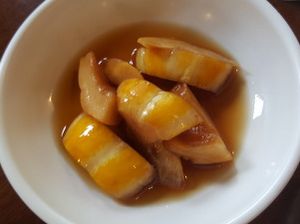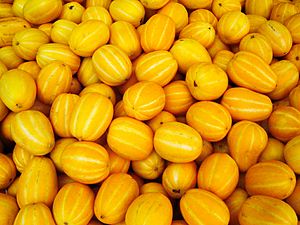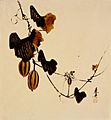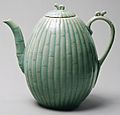Oriental melon facts for kids
Quick facts for kids Oriental melon |
|
|---|---|
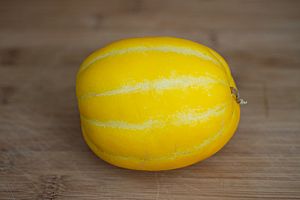 |
|
| Species | Cucumis melo |
| Cultivar group | makuwa |
The oriental melon is a type of melon grown mainly in East Asia. Scientists believe it might have first grown in eastern India. From there, it traveled to China along the famous Silk Road, and then made its way to Korea and Japan.
This melon tastes a bit like a mix between a honeydew melon and a cucumber. It's not as sweet as many Western melons and is about 90% water! People usually eat oriental melons fresh. Since their skin is thin and seeds are small, you can often eat the whole melon.
Contents
What is an Oriental Melon?
Oriental melons are known by different names depending on where you are in Asia.
In China, it's often called xiāng guā (香瓜), which means "fragrant melon." Long ago, it was also called "sweet melon" or "fruit melon," but those names are not used much anymore. Today, tián guā (甜瓜) is the general name for all types of Cucumis melo, including melons like cantaloupe and honeydew.
The Korean Chamoe
The Korean name for oriental melon is chamoe (참외). This name combines cham, meaning "true" or "real," and oe, meaning "cucumber" or "melon." It's thought that chamoe came to Korea from China during the Three Kingdoms period (around 57 BC to 668 AD).
Chamoe is a very popular summer fruit in Korea. People often make a side dish called chamoe-jangajji by pickling the melons with spices. In 2017, about 41,943 hectares (that's like 103,643 acres) of land were used to grow these melons, producing about 166,281 tons of fruit! Seongju County in North Gyeongsang Province, South Korea, is especially famous for growing chamoe. About 70% of all chamoe in Korea comes from this area.
Japanese Makuwa Uri
In Japan, these melons are called makuwa uri (真桑瓜). Archeologists have even found oriental melon seeds at ancient Jōmon period sites, showing they've been grown in Japan for a very long time. The name makuwa uri comes from a village called Makuwa, which was known for its great oriental melons around 200 AD.
These melons used to be very common in Japan. The general word uri (瓜), which means gourd or melon, even came to specifically mean the oriental melon! However, after 1925, when Western melons were brought to Japan, the oriental melon became less popular, especially among wealthier people. By the late 1900s, some even thought of it as a "peasant food."
Today, makuwa uri is often used as an offering during the Bon Festival, a Japanese Buddhist custom. The time around this festival is considered the best time to harvest them. Unripe melons are also often made into different kinds of tsukemono (pickles).
How Oriental Melons Grow
Oriental melons are cool-weather plants. They grow best when daytime temperatures are between 24 and 28 degrees Celsius (75-82°F) and nighttime temperatures are between 16 and 24 degrees Celsius (61-75°F). They need plenty of sunlight and rich, well-drained soil that holds moisture well. While they can handle some dry weather, they need enough water to grow their best.
This plant is an annual herbaceous plant, meaning it lives for only one growing season and has soft stems. It branches out and trails along the ground. The stem is hairy and about 7 millimeters (0.28 inches) thick. Its leaves are shaped like kidneys and have 5-7 lobes. The plant has both male and bisexual (male and female parts) yellow flowers.
Types of Oriental Melons
There are many different types, or varieties, of oriental melon!
Popular Varieties
One of the most famous varieties is called ginsen makuwa in Japanese and euncheon-chamoe (은천참외) in Korean. This melon was first grown in Toyama, Japan. It's now considered a "traditional vegetable" there.
This type of melon came to Korea in 1957 and quickly became the most popular kind grown for sale. Many of the chamoe grown today are descendants of the euncheon variety. For example, sin-euncheon ('new euncheon') was developed in the 1970s, and geumssaragi-euncheon (금싸라기은천, 'gold dust euncheon'), developed in 1984, is now the most common.
The euncheon type is usually yellow, about 6 inches (15 cm) long, and weighs around 1 pound (450 g). It's smooth and oval-shaped, with white stripes along its length. The inside flesh is white, juicy, and sweet, with small white seeds. Other types of oriental melons can be green or ivory in color, and their shapes can range from round to oval.
Korean Landraces
In Korea, there are two main traditional types of chamoe called landraces. These are sunghwan-chamoe (성환참외), also known as gaeguri-chamoe (개구리참외, 'frog chamoe'), and Gotgam-chamoe (곶감참외).
The gotgam-chamoe is very special because it smells like a dried persimmon (which is called gotgam in Korean), and that's how it got its name! These two traditional types of chamoe have more nutrients and are better at resisting plant diseases than other varieties.
Japanese Varieties
The Golden Makuwa (error: {{nihongo}}: Japanese or romaji text required (help)) is a special variety recognized by the government of Nara Prefecture as a "Yamato vegetable." This means it's important to the area's farming and food traditions. It has golden skin, white flesh, and usually weighs about 300 grams (10.6 ounces). In 1955, Golden Makuwa made up a huge 85.6% of all melons sold at the Osaka Central Wholesale Market!
Another variety, the New Melon (error: {{nihongo}}: Japanese or romaji text required (help)), is round with greenish-yellow skin and green flesh. It usually weighs about 300–400 grams (10.6-14.1 ounces). In 1962, a company called Sakata Seed crossbred this melon with a European cantaloupe to create the Prince Melon (error: {{nihongo}}: Japanese or romaji text required (help)). This new melon quickly became the most popular commercial melon in Japan. Prince melons weigh between 500 and 600 grams (1.1-1.3 pounds), have grayish-white skin, and orange flesh.
The creation of sweeter and easier-to-grow hybrid melons like the Prince led to a quick drop in the growing of traditional oriental melons in Japan.
Cultural Importance
Oriental melons are important in the culture of East Asian countries.
In South Korea, two National Treasures (numbers 94 and 114) are actually shaped like an oriental melon! This shows how much they were valued in the past.
Each year, the Yeoju Geumsa Oriental Melon Festival (여주 금사참외축제) is held. Visitors can try the delicious melons there. There's also an Oriental Melon Ecology Centre in Seongju County, which teaches people about how the fruit is grown and other interesting facts.
In Japan, an 18th-century artist named Yosa Buson even drew a picture of an "oriental melon monster" (真桑瓜のばけもの (makuwauri no bakemono)) in his collection of Japanese yōkai (supernatural beings).
A sign promoting 'the birthplace of the oriental melon' stands at Kitagata-Makuwa Station in Motosu, Gifu, Japan. This marks the spot of the old Makuwa village, famous for its melons.
-
Print of oriental melons on the vine by Shibata Zeshin
-
Melon-shaped Celadon Bottle from Goryeo (918–1392), at the National Museum of Korea
-
Melon-shaped Celadon Bottle with Inlaid Peony and Chrysanthemum Design from Goryeo, at the National Museum of Korea
-
Melon-shaped Celadon Kettle from Goryeo, at the Metropolitan Museum of Art
-
Melon-shaped lacquerware from Joseon, at the Los Angeles County Museum of Art
-
18th century drawing by Yosa Buson of an "oriental melon monster".
-
The original Japanese melonpan was produced in the shape of an oriental melon.
Gallery
-
Oriental melon stall in Seoul, South Korea
See also
 In Spanish: Melón coreano para niños
In Spanish: Melón coreano para niños


